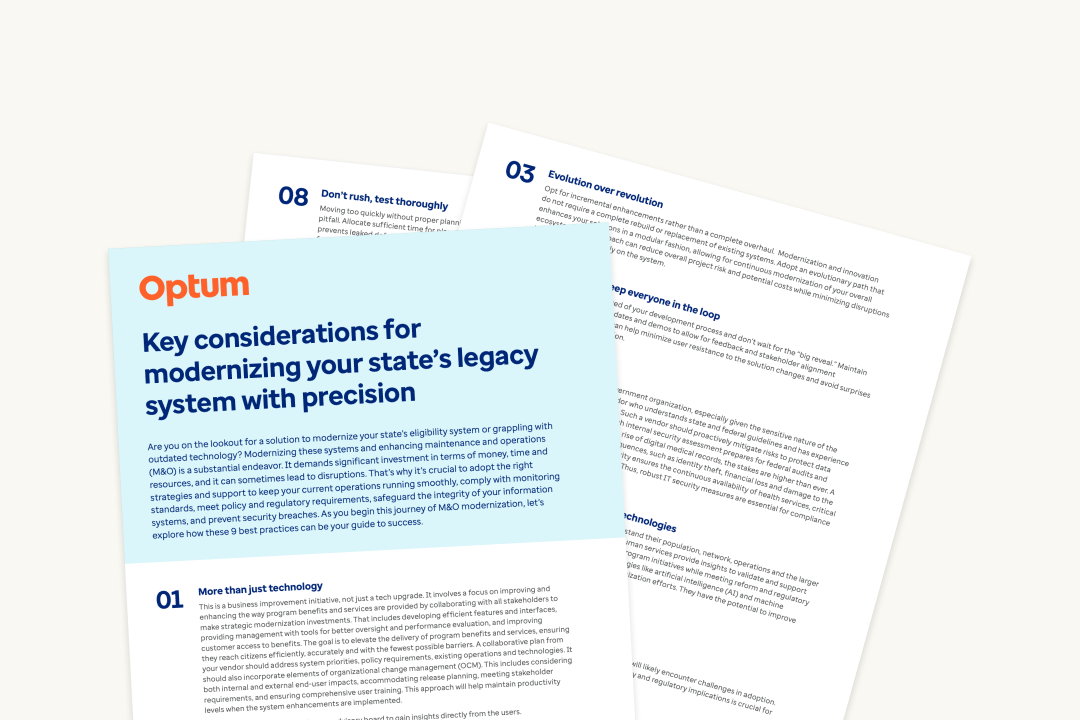Modernize systems to enhance performance and empower users
Optum Maintenance and Operations (M&O) Services offers a structured approach to healthcare eligibility and enrollment systems takeover and management. We enhance system performance and user satisfaction through 4 key stages:
- Transition
- Stabilize
- Transform
- Optimize
Our services help ensure that systems are maintained and continuously improved to align with the evolving needs of your business and users.
States are actively updating their eligibility and enrollment (E&E) systems to enhance workforce support and services for their constituents. But there are many challenges to modernizing healthcare systems management.
- Aging systems are expensive and complex to maintain. They often fail to meet current standards for policy, compliance and user experience.
- Rapid policy changes are a challenge due to system inflexibility. States must choose between incremental updates or complete overhauls while managing everyday operations.
- The Public Health Emergency (PHE) and the allure of better paying private-sector jobs with advanced technologies strain resources further.
- Many systems lack proper integration, which complicates management and alignment with current needs. States also deal with disparate and isolated data sources, which are crucial for analytics.
Choosing an effective approach is key to modernizing systems, addressing operational challenges, and supporting digital transformation and innovation efforts.
Bring innovation to your operations to drive business success

A better path to modernization
Our comprehensive, agile services ensure existing operations are efficiently managed today while continuously improving system performance to meet challenges in the future.
Our human-centered approach integrates the customer voice and industry trends. We’ll work with you to identify the best path to modernization that reduces total cost of ownership and enhances user experience.

Seamless transition with collaboration, expertise and capabilities
We help with secure transfer of knowledge and responsibilities to our teams. We establish a solid foundation through expert collaboration, critical success factors and acceptance criteria.
We implement best practices with the support of knowledgeable subject matter experts (SMEs), effective communication and operational reporting.

Stabilize baseline business and system support
We set baseline functionality and environment levels for business and system support activities. We include ITIL-based incident and problem management to decrease incident and problem tickets and enhance end-user self-service capabilities.

Transform: Enhance quality and productivity
We aim to boost the quality and productivity of your system. We do this through root-cause analysis, security and data protection compliance, and the continuous enhancement of operational best practices and tools.
Our goal is to improve monitoring, alerting and reporting to ensure compliance with solution SLA baselines.

Optimize with continuous improvements
Our continuous enhancement efforts include code fixes and automation. We stress solution modernization through an evolution, not a revolution, approach.
This strategy allows for incremental enhancements without disrupting daily operations. Additionally, we focus on user-centric design updates, market research, security compliance checks and remediation.
We regularly seek feedback from users to guide preventive maintenance, so your system remains effective and up to date.
Streamline operations with expertise and innovation
We help you transform challenges into opportunities for growth and improvement.
Configurability and expertise in federal policies
We simplify the complexities of evolving federal policies and translate them into actionable, compliant updates for systems and processes.
Incremental modernization
Gradual modernization reduces the risk of disruption and safeguards access to essential healthcare and benefits.
Automation and efficiency
We automate manual processes to boost your program's efficiency and free up your team to focus on what truly matters.
Data and analytics
Our broad data and analytics capabilities improve decision-making and provide an integrated view of your enterprise.
Strategic planning support
As a strategic ally, we help you plan and prepare for system upgrades and changes. This creates a smooth transition that’s easy to navigate.
Lower your TCO with continuous innovation
Our continuous improvement process enhances system maturity and usability while lowering costs and alleviating administrative burdens.
Adaptability to changing needs
Our flexible approach to modernization helps you adapt quickly as needs evolve to remain responsive and resilient when it matters most.
Enhanced user experience
Integrating technologies into a single interface enhances the user experience and offers personalized interaction and mobile-first access.
Experience the cloud
Moving to the Optum cloud enhances agility, security and administration. Improved processes and accessibility ready you for what's next.
The Optum Maturity Model assesses and enhances IT service efficiency, cost-effectiveness and quality. Through maturity assessments, we identify improvement areas to align enhancements with business goals.
The model evaluates IT services across 5 segments, such as incident and service management. It provides scores to pinpoint improvements. Maturity levels range from 0 to 5:
- Initial (0–1): Ad-hoc, chaotic processes
- Repeatable (1–3): Documented processes for repeatability
- Defined (2–3): Standardized, detailed processes
- Managed (3–4): Processes managed by metrics
- Optimized (4–5): Continuously optimized processes
This streamlined approach tracks IT service maturity and fosters a collaborative environment for continuous improvement. It directly links advancements to better support operational efficiency.
An evolutionary approach to enhancing technology systems allows gradual modernization that integrates within your existing ecosystem. It promotes innovation in manageable segments without disrupting the daily operations of agencies relying on your systems.
Upgrading one module at a time allows you to more quickly implement system enhancements. And it simplifies the process for end-users to adapt to the changes, ensuring smoother transitions and continuous improvement.
Start your modernization journey with both the business and human aspects of issues you would like to address. Understanding an issue from multiple perspectives helps ensure that solutions benefit not only your processes and technology, but also the people involved.
By considering the user experience, states can gain a comprehensive understanding of the problems they’re facing.
For example, in Massachusetts, the non-MAGI legacy Eligibility System struggled with a cumbersome, 38-page paper application that had to be manually entered by an employee.
The system was not user-friendly as applicants couldn’t access their data. It did not integrate with other systems, creating inefficiencies and user difficulties.
Recognizing the difficulties users had with the application process and identifying the system's inability to interact with other systems was crucial to taking the next step towards finding a solution.
There are many approaches states are taking to modernize rather than “rip and replace.” Integrating certain, less intrusive technologies can be a good place to start.
For example, AI-powered tools like chatbots and virtual assistants can automate communications and offer 24/7 self-service options. This can help improve the user experience and operational efficiency.
Digital adoption platforms can be layered on top of existing applications to guide users through complex processes. This helps simplify the user experience and accelerate learning.
Additionally, business process management and mining can be employed to optimize and automate workflows. It also helps identify and address bottlenecks for continuous improvement.
Robotic process automation (RPA) eliminates time-consuming manual tasks, reduces errors and frees up resources for more strategic initiatives.
Together, these technologies streamline operations, improve service delivery and reduce costs without disrupting existing systems.
Industry insights

Case study
States can build on a step-by-step approach to modernization, incrementally transforming the user experience without disruption.

Article
Dr. Garry Choy, CMO, discusses the pros and cons of using automation and clinical decision support to meet today’s workforce challenges.

Article
Robotics process automation can improve maintenance and operations of state Medicaid systems.
Complementary solutions
Optum Integrated Eligibility Services
Our benefit determination system for Medicaid and human services programs simplifies eligibility for cost-effectiveness and efficiency.
Optum State-Based Exchanges
Optum State-Based Exchanges provide a robust and user-friendly SaaS approach for states looking to establish an ACA-compliant marketplace.
One Assist
Our AI-enabled contact center solution helps states connect providers and members to the answers they need.
